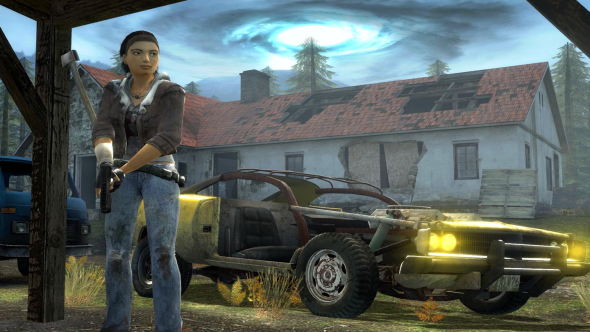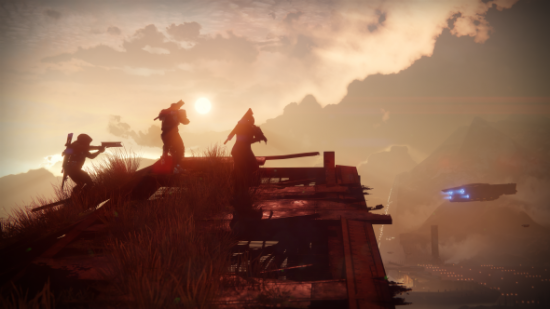“Where is the European Dead Zone? In Europe, I mean?”
“I don’t know.” Matt’s voice was tinny over VoIP. He, along with Hawthorne and Devrim Kay, had been guiding me through Destiny 2’s European Dead Zone (EDZ) for a couple of hours by this point. Once I’d got the hang of the double jump, and started to get over booping the Fallen in the face with my knife, I’d begun to wonder. Bungie’s setting is vague – intentionally so, you’d imagine, to allow their universe a little distance from the stricture of real-world culture and geography. But if you’re European, you can’t help but pick up on some of the more specific signifiers.
Related: how to get raid-ready in Destiny 2.
I mean, it definitely is Europe: the landscape is dotted with jutting rocks and steep outcrops, but the tall pines and placid lakes belong to a temperate climate. Those austere, concrete tower blocks say Eastern Europe, yet the brick chimneys suggest mills from a long-abandoned 20th century industrial past – a little like that of my own northern England. Devrim’s church, meanwhile, has a spiky, Cologne-style spire.

Also: I’m pretty sure, down in the tunnels that span the length and breadth of the Dead Zone, I saw a sign in German. Since then, I’ve tried to spell out the scuffed signs outside of what might once have been shops. Schnel? Amsel? Perhaps this is what German evolved into – Destiny 2 is set 700 years in the future, after all.
Ultimately, though, those clues don’t conjure a specific country for me so much as a specific game – Half-Life 2: Episode 2.
Valve were vague too. City 17 was situated in Eastern Europe but they never said where. And once you left it, after the events of Episode 1, the cars looked like Trabants. “Ah yes,” you might have thought while picking one up with the Gravity Gun and chucking it at an Antlion. “That symbol of East Germany.”

Out in the forest, the pines were so tall they dwarfed the Striders. There were tunnels, too – mines, maybe – just like those in the EDZ. And in the background, lightning arced continuously from the ruined Citadel up into the sky, lending an otherworldly edge to the boulder-strewn countryside. A gigantic, cracked Traveler shard does the same for the EDZ. Imposing, curvy objects in the skybox are something of a Bungie speciality, I suppose.
If the EDZ is an update of Episode 2, intentionally or not, there’s one place it improves on Valve’s vision. Viktor Antonov, the celebrated Bulgarian game artist, designed City 17 to recall the “eastern frontier territory” of Ukraine and Russia. He layered its imperial architecture with industrial machinery – just as he did in Dishonored’s Dunwall, and the cancelled Battlecry – that suggested totalitarianism.
Outside the city, in Episode 2, that yoke was released. The mark of the Combine wasn’t so apparent on the countryside. But it still felt a little bare – the Source engine at the time tending to look a bit cold and stiff whatever you did with it.

The EDZ, by contrast, layers its countryside in Antonov-like fashion – not with alien machinery, but with flora. Bungie have filled it with the lush undergrowth that triple-A tech now allows, and covered its buildings with creeping vines and green climbers. It feels like a landscape reclaimed by nature – so much so that when Hawthorne likens the Last City to a prison, you know what she means.
It feels pertinent to point out that the European Dead Zone is the largest playable space Bungie have ever made, just as Episode 2 was the first time Valve had gone wide with expansive environments. Both felt like worlds set free.
The gaps on its map suggest the EDZ will only get bigger with updates and DLC. I hope it does, and that it retains that peculiar but particular European flavour that screams Half-Life 2. With Episode 3 now pronounced dead by the man who would have been its writer, this might be the closest we ever get to returning to City 17 and its environs.
